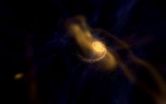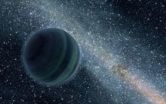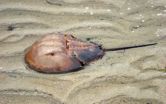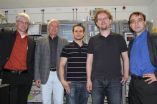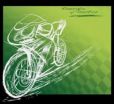(Press-News.org) How unique is the Milky Way?
To find out, a group of researchers led by Stanford University astrophysicist Risa Wechsler compared the Milky Way to similar galaxies and found that just four percent are like the galaxy Earth calls home.
"We are interested in how the Milky Way fits into the broader context of the universe", said Wechsler. "This research helps us understand whether our galaxy is typical or not, and may provide clues to its formation history."
The research team compared the Milky Way to similar galaxies in terms of luminosity--a measure of how much light is emitted--and distance to other bright galaxies. They found galaxies that have two satellites that are as bright and close by as the Milky Way's two closest satellites, the Large and Small Magellanic Clouds, are rare.
Published in the May 20 issue of the Astrophysical Journal, the findings are based on analyses of data collected from the Sloan Digital Sky Survey (SDSS). The work is the first of three papers that study the properties of the Milky Way's two most massive satellites.
Supported in part by the National Science Foundation (NSF), the SDSS is the most extensive survey of the optical sky performed to date.
In more than eight years of operations, SDSS has obtained images covering more than a quarter of the sky, and created 3-dimensional maps containing more than 930,000 galaxies and 120,000 quasars. For this analysis, Wechsler's group studied more than 20,000 galaxies with properties similar to the Milky Way and investigated the galaxies surrounding these Milky Way "twins", to create a "census" of galaxies similar to the Milky Way in the universe.
The work represents one of the most extensive studies of this kind ever performed.
Scientists can also compare the SDSS data to galaxies simulated by a computer model. Since they are currently unable to see all the way back to the Big Bang, this is one way researchers are trying to understand how the universe as we see it today began.
In order to learn more about possible conditions in the early universe, the group performed computer simulations to recreate the universe from specific sets of starting conditions. Then they compared their simulations to the SDSS data set. In this way, the group was able to test different theories of galaxy formation to determine whether or not each would result in a universe that matches what we see today. The results of their simulation matched the result found in the SDSS data set: just four percent of the simulated galaxies had two satellites like the Magellanic Clouds.
"This is an excellent example of data-enabled science," said Nigel Sharp, of NSF's Division of Astronomical Sciences. "Comparing the 'fake' and 'real' Universes is how we discriminate between successful and unsuccessful theories. This work interconnects three of the four legs of science: theory, observation and simulation, for a powerful scientific result."
Their results also lend support to a leading theory of galaxy formation called the Cold Dark Matter (CDM) theory. This theory provides what many consider to be the simplest explanation for the arrangement of galaxies throughout the universe following the Big Bang. It assumes that most of the matter in the Universe consists of material that cannot be observed by its electromagnetic radiation (dark) and whose constituent particles move slowly (cold). Dark matter, an invisible and exotic material of unknown composition, is believed to influence the distribution of galaxies in space and the overall expansion of the universe. The rareness of this aspect of the Milky Way may provide clues to its formation history.
"Because the presence of two galaxies like the Magellanic Clouds is unusual, we can use them to learn more about our own galaxy," said Wechsler. Using their simulation, the team identified a sample of simulated galaxies that had satellites matching the Milky Way's in terms of their locations and speeds.
"The combination of large surveys of the sky like the SDSS and large samples of simulated galaxies provides a new opportunity to learn about the place of our galaxy in the Universe," said Wechsler. "Future surveys will allow us to extend this study to even dimmer satellite galaxies, to build a full picture of the formation of our galaxy."
INFORMATION:
The theoretical and numerical work that produced the simulations used as a comparison for the SDSS data were supported by an award funded under the American Recovery and Reinvestment Act of 2009.
Just 4 percent of galaxies have neighbors like the Milky Way
Our home galaxy belongs to a rare subset among the billions that populate the cosmos
2011-05-23
ELSE PRESS RELEASES FROM THIS DATE:
Common Jupiters?
2011-05-23
Freelance writer Robert Brault offers a metaphor for the night sky, "A trillion asterisks and no explanations." By supporting astronomers, the National Science Foundation (NSF) helps to provide explanations. A recent NSF- and NASA-funded study provides one more explanation.
Astronomers have discovered a new population of Jupiter-size planets floating alone in the dark of space, away from the light of a star. According to the scientists, these lone worlds were probably ejected from developing planetary systems.
The discovery is based on a joint Japan-New Zealand survey, ...
Mount Sinai researchers discover possible new target for sarcoma treatment and prevention
2011-05-23
Researchers from Mount Sinai School of Medicine have discovered a protein signaling pathway that becomes hyperactivated in human sarcoma cells, suggesting that medications to inhibit this pathway may be effective in the treatment of human sarcomas. The research is published in the current issue of the journal Cancer Cell.
A team of researchers led by Stuart Aaronson, MD, Jack and Jane B. Aron Professor and Chairman of the Department of Oncological Sciences at Mount Sinai School of Medicine, compared normal human mesenchymal stem cells to human sarcoma cells and found ...
American Community Television Calls on AT&T to Make PEG Channels Available to the Blind and Vision Impaired Community
2011-05-23
American Community Television (ACT) sent letters last Thursday to Randall Stephenson, the President of AT&T, and to Jacquelyn Brand, the chair of the AT&T Advisory Panel on Access & Aging, asking that AT&T deliver Public, Educational and Government (PEG) access channels the same as all other channels on the U-Verse system.
"AT&T's U-Verse platform discriminates against persons who are blind or visually impaired," said John Rocco, President of ACT. "We cannot access PEG channels through the Channel 99 on-screen menu."
Mr. Rocco, ...
Replacing the blue bloods
2011-05-23
The Food and Drug Administration requires every drug they certify to be tested for certain poisons that damage patient health. The current gold standard for this is the limulus amoebocyte lysate (LAL) assay that involves using the blood of horseshoe crabs, which strangely enough is blue, to test for endotoxin, a substance commonly associated with many symptoms caused by bacterial infections.
But researchers at the Department of Chemical and Biological Engineering at the University of Wisconsin-Madison have found what may be a more effective way to test for endotoxin that ...
Novel man-made material could facilitate wireless power
2011-05-23
DURHAM, N.C. – Electrical engineers at Duke University have determined that unique man-made materials should theoretically make it possible to improve the power transfer to small devices, such as laptops or cell phones, or ultimately to larger ones, such as cars or elevators, without wires.
This advance is made possible by the recent ability to fabricate exotic composite materials known as metamaterials, which are not so much a single substance, but an entire man-made structure that can be engineered to exhibit properties not readily found in nature. In fact, the metamaterial ...
Whataburger Introduces New Honey Mustard Chicken Club Sandwich
2011-05-23
Just in time for summer, Whataburger today announced the Honey Mustard Chicken Club, its newest menu item available for a limited time only. The new chicken sandwich - with a choice of grilled or crispy chicken -- is available Monday, May 23 at 3 p.m. through Monday, June 27 at Whataburger's 700-plus locations across 10 states.
The made-to-order Honey Mustard Chicken Club sandwich features a choice of Grilled Chicken or Whatachick'n filet, freshly chopped lettuce, tomato, bacon, Swiss American cheese and Honey Mustard sauce on a wheat bun. It is the newest addition to ...
USDA/AIA survey reports 2010/2011 winter honey bee losses
2011-05-23
This release is available in Spanish.
WASHINGTON - Total losses from managed honey bee colonies nationwide were 30 percent from all causes for the 2010/2011 winter, according to the annual survey conducted by the U.S. Department of Agriculture (USDA) and the Apiary Inspectors of America (AIA).
This is roughly similar to total losses reported in similar surveys done in the four previous years: 34 percent for the 2009/2010 winter, 29 percent for 2008/2009; 36 percent for 2007/2008, and 32 percent for 2006/2007.
"The lack of increase in losses is marginally encouraging ...
World record in ultra-rapid data transmission
2011-05-23
This release is available in German.
Scientists of Karlsruhe Institute of Technology (KIT) have suc-ceeded in encoding data at a rate of 26 terabits per second on a single laser beam, transmitting them over a distance of 50 km, and decoding them successfully. This is the largest data volume ever transported on a laser beam. The process developed by KIT allows to transmit the contents of 700 DVDs in one second only. The renowned journal "Nature Photonics" reports about this success in its latest issue (DOI: 10.1038/NPHOTON.2011.74).
With this experiment, the KIT scientists ...
An electric motorcycle is created at Carlos III University of Madrid
2011-05-23
This release is available in Spanish.
This project, known as e-Moto, was created and developed by LGN Tech Design, a spin-off company that has its origins in a line of research begun in the Laboratorio de Máquinas (MAQLAB – Machine Laboratory) of UC3M and receives support from the University's Vice-Chancellor's Office of Research through the Business Incubator UC3M Science Park. "The technology that we have developed is a result of the design of a platform for the modeling, analysis and evolution of racing motorcycles, which was then applied to the development of the ...
Bruegger's Adds New Cafe Salad to Its Flavorful Lunch Menu
2011-05-23
Today Bruegger's announced the addition of a new line of "Cafe Salads" to its lunch menu. Part of its summer-long healthy menu initiative, the salads are available in five chef-created options at all of Bruegger's 300 plus bakeries.
According to the National Restaurant Association, nutrition and health continue to be in high demand from consumers, along with a focus on value. Bruegger's Cafe Salads meet this growing trend, offering guests fresh, great tasting options in a lunch portion size with fewer calories and all the taste. And, at just $4.99 (prices ...
LAST 30 PRESS RELEASES:
Numbers in our sights affect how we perceive space
SIMJ announces global collaborative book project in commemoration of its 75th anniversary
Air pollution exposure and birth weight
Obstructive sleep apnea risk and mental health conditions among older adults
How talking slows eye movements behind the wheel
The Ceramic Society of Japan’s Oxoate Ceramics Research Association launches new international book project
Heart-brain connection: international study reveals the role of the vagus nerve in keeping the heart young
Researchers identify Rb1 as a predictive biomarker for a new therapeutic strategy in some breast cancers
Survey reveals ethical gaps slowing AI adoption in pediatric surgery
Stimulant ADHD medications work differently than thought
AI overestimates how smart people are, according to HSE economists
HSE researchers create genome-wide map of quadruplexes
Scientists boost cell "powerhouses" to burn more calories
Automatic label checking: The missing step in making reliable medical AI
Low daily alcohol intake linked to 50% heightened mouth cancer risk in India
American Meteorological Society announces Rick Spinrad as 2026 President-Elect
Biomass-based carbon capture spotlighted in newly released global climate webinar recording
Illuminating invisible nano pollutants: advanced bioimaging tracks the full journey of emerging nanoscale contaminants in living systems
How does age affect recovery from spinal cord injury?
Novel AI tool offers prognosis for patients with head and neck cancer
Fathers’ microplastic exposure tied to their children’s metabolic problems
Research validates laboratory model for studying high-grade serous ovarian cancer
SIR 2026 delivers transformative breakthroughs in minimally invasive medicine to improve patient care
Stem Cell Reports most downloaded papers of 2025 highlight the breadth and impact of stem cell research
Oxford-led study estimates NHS spends around 3% of its primary and secondary care budget on the health impacts of heat and cold in England
A researcher’s long quest leads to a smart composite breakthrough
Urban wild bees act as “microbial sensors” of city health.
New study finds where you live affects recovery after a hip fracture
Forecasting the impact of fully automated vehicle adoption on US road traffic injuries
Alcohol-related hospitalizations from 2016 to 2022
[Press-News.org] Just 4 percent of galaxies have neighbors like the Milky WayOur home galaxy belongs to a rare subset among the billions that populate the cosmos
